Sagittarius A (Sgr A) is a complex radio source located at the centre of the Milky Way Galaxy. The radio source consists of the supernova remnant Sagittarius A East, the spiral structure Sagittarius A West, and the bright compact radio source at the centre of the spiral structure, called Sagittarius A*.
Sagittarius A* (pronounced “Sagittarius A-star”) is the supermassive black hole at the centre of our galaxy. The Milky Way’s central black hole lies at a distance of 26,673 ± 42 light years from Earth in the direction of Sagittarius constellation, near the border with Scorpius.
Sagittarius A cannot be seen in optical wavelengths because of the effect of 25 magnitudes of extinction. The source is hidden from view by large dust clouds in the Milky Way’s spiral arms. The Galactic centre is best observed in the infrared and radio bands. The radio and infrared emissions from Sgr A come from dust and gas being heated to millions of degrees as they fall into the central black hole.
The first image of the black hole at the center of the Milky Way Galaxy was released in May 2022. It was the second image of a galactic black hole to be produced. The first black hole to be imaged lies at the centre of the galaxy Messier 87, one of the brightest members of the Virgo Cluster.
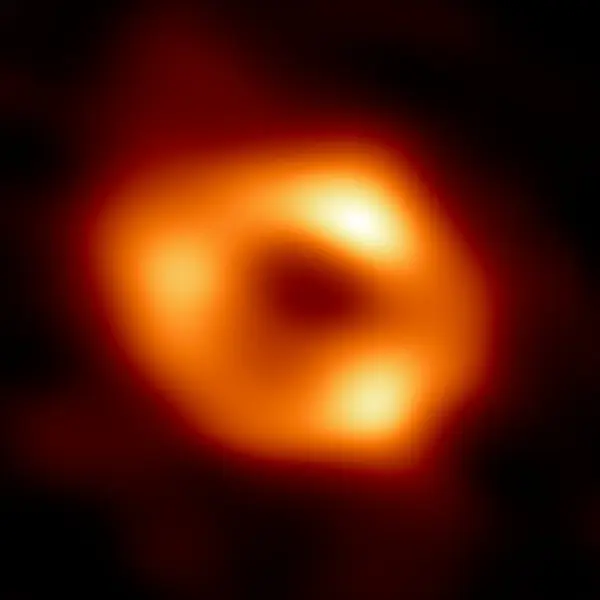
This is the first image of Sgr A*, the supermassive black hole at the centre of our galaxy. It’s the first direct visual evidence of the presence of this black hole. It was captured by the Event Horizon Telescope (EHT), an array which linked together eight existing radio observatories across the planet to form a single “Earth-sized” virtual telescope. The telescope is named after the event horizon, the boundary of the black hole beyond which no light can escape. Although we cannot see the event horizon itself, because it cannot emit light, glowing gas orbiting around the black hole reveals a telltale signature: a dark central region (called a shadow) surrounded by a bright ring-like structure. The new view captures light bent by the powerful gravity of the black hole, which is four million times more massive than our Sun. The image of the Sgr A* black hole is an average of the different images the EHT Collaboration has extracted from its 2017 observations. Credit: EHT Collaboration
Sagittarius A* (Sagittarius A-star)
Sagittarius A* is the Milky Way’s central supermassive black hole. It has a mass of 4.154 million Suns packed within a diameter of 51.8 million kilometres (32.2 million miles). This is less than the distance between Mercury and the Sun at the planet’s closest approach (46 million km).
The black hole is notable for its weak emission. With a bolometric luminosity only about 100 times that of the Sun, it would be difficult to detect if not for its proximity. In 2019, observations with NASA’s Stratospheric Observatory for Infrared Astronomy (SOFIA) provided a possible explanation for the relatively low emissions coming from Sgr A*. They revealed that magnetic fields cause the ring of dust and gas around Sgr A* to flow into an orbit around the black hole. Some of the material falls toward the black hole, but some of it is directed away from it, keeping emissions low.
Sagittarius A*
| Constellation | Sagittarius |
| Right ascension | 17h 45m 40.03599s |
| Declination | −29° 0′ 28.1699″ |
| Distance | 26,673 ± 42 light-years (8,178 ± 13 parsecs) |
| Mass | (4.154 ± 0.014) × 106 M☉ |
| Proper motion | RA: -2.70 mas/yr |
| Dec.: -5.6 mas/yr |
Name
The name Sagittarius A was given to the radio source by John D. Kraus, Hsien-Ching Ko, and Sean Matt (Ohio State University), who listed all the radio sources they detected in the sky and arranged them by constellation in 1954. The letter A denoted the brightest radio source in Sagittarius, the Archer.
The asterisk (*), pronounced “star,” was added by Robert L. Brown in 1982 because the source was considered “exciting.” It is a reference to the naming system for excited state atoms, which are given an asterisk to denote their excited state.
Brown and his team had obtained a high-resolution map of the Galactic centre using the Very Large Array (VLA) and understood that the strongest radio emission from the Galactic centre was coming from a compact nonthermal radio object.
Sagittarius A* image
The first image of Sagittarius A* was revealed at a press conference held on May 12, 2022. Produced by the Event Horizon Telescope (EHT) Collaboration, the image is direct visual evidence of the existence of the supermassive black hole in the heart of the Milky Way.
While the black hole itself cannot be seen, the glowing gas around it reveals its presence. Sagittarius A* appears as a shadow, a dark region surrounded by a bright ring-like structure. The EHT Collaboration used many innovative techniques to determine the size of the ring to be 51.8 ± 2.3 microarcseconds and of the shadow, 48.7 microarcseconds. At a distance of 26,000 light-years, this translates into a physical diameter of 51.8 million kilometers.
The bright ring is the result of lensed emission, and its diameter agrees with Albert Einstein’s theory of general relativity (also known as Einstein’s theory of gravity) based on its distance and mass. The temperature of the ring’s hot plasma is estimated to be 10 billion K (18 billion F).
Some of the glowing gas in the image of Sgr A* is in fact behind the black hole. Its light is bent by the gravity of Sgr A*. This effect is known as gravitational lensing. It is one of the key predictions of general relativity.
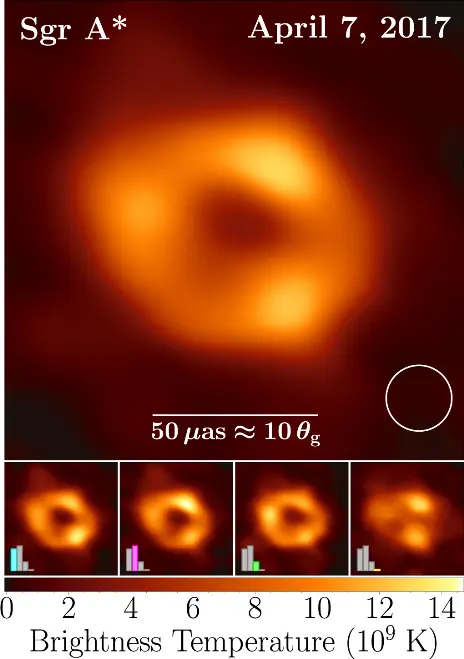
A synthetic image of the black hole at the centre of the Milky Way galaxy, Sagittarius A*. Image: Kazunori Akiyama, Antxon Alberdi, Walter Alef, Juan Carlos Algaba, Richard Anantua, Keiichi Asada, Rebecca Azulay, Uwe Bach, Anne-Kathrin Baczko, David Ball (CC BY-SA 4.0)
Event Horizon Telescope
To image Sagittarius A*, the EHT team linked together eight radio observatories at six sites around the globe to form a single virtual telescope. More than 300 researchers from 80 institutes around the world participated in the EHT Collaboration. The institutes of the EHT consortium include the Center for Astrophysics (Harvard & Smithsonian), the Max Planck Institute for Radio Astronomy in Germany, the MIT Haystack Observatory in Massachusetts, the National Astronomical Observatory of Japan, the Perimeter Institute for Theoretical Physics in Ontario, Canada, and the Radboud University in the Netherlands.
The Milky Way’s central black hole was observed on five nights in April 2017. The observations were presented in The Astrophysical Journal Letters.
The global network of radio telescopes used to produce the image of Sgr A* included ESO’s Atacama Large Millimeter/submillimeter Array (ALMA) and the Atacama Pathfinder EXperiment (APEX) in the Atacama Desert in Chile, the Large Millimeter Telescope Alfonso Serrano (LMT) on Volcán Sierra Negra in Mexico, the James Clerk Maxwell Telescope (JCMT) and Submillimeter Array (SMA) on Maunakea in Hawaii, the UArizona Submillimeter Telescope (SMT) on Mt. Graham in Arizona, the Institut de Radioastronomie Millimétrique (IRAM) 30 m telescope (PV) on Pico Veleta in Spain, and the South Pole Telescope (SPT) at the Amundsen–Scott South Pole Station in Antarctica. The EHT team has since added the NOrthern Extended Millimeter Array (NOEMA) in France, the Greenland Telescope (GLT), and the UArizona 12-meter Telescope on Kitt Peak to the array.
In 2017, each observatory collected light data using high-speed recorders, designed to process large amounts of data at rates of 4 gigabytes per second. The recorders were developed at Haystack Observatory. The observatories collected almost 4 petabytes (4,000 terabytes) of data. The hard drives with the recorded data were sent to Haystack Observatory and the Max Planck Institute for Radio Astronomy in Bonn, Germany, for processing. The data was combined by a supercomputer hosted by the Max Planck Institute.
The data collected by the EHT team is being used by researchers to test gravity theories, black hole models, and fundamental physics. The high-precision measurements of the shadow and surrounding ring offer scientists an unprecedented insight into the spacetime around event horizons of supermassive black holes.
Sagittarius A* is the second supermassive black hole to be directly imaged. The Event Horizon Telescope previously imaged the black hole in the supergiant elliptical galaxy Messier 87 (Virgo A), the largest and second brightest galaxy in the Virgo Cluster. The data to produce the EHT image was also collected in April 2017. The first image of a black hole was unveiled on April 10, 2019. The results of the EHT observations were announced by Heino Falcke (Radboud University Nijmegen), one of the leaders of the EHT Collaboration. The black hole in M87 has a mass of 6.5 billion suns. It was named Pōwehi, meaning “the adorned fathomless dark creation” in Hawaiian. The galaxy M87 lies 53.5 million light-years away.
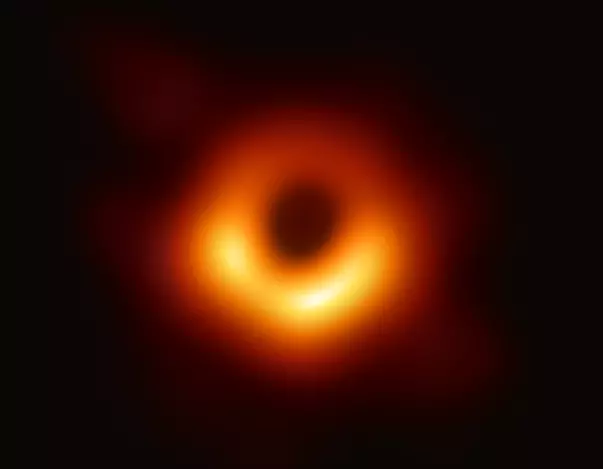
In this image of M87* taken on 11 April 2017 (a representative example of the images collected in a global 2017 EHT campaign), the shadow of a black hole is the closest we can come to an image of the black hole itself, a completely dark object from which light cannot escape. The black hole’s boundary — the event horizon from which the EHT takes its name — is around 2.5 times smaller than the shadow it casts and measures just under 40 billion km across. Image: Event Horizon Telescope (CC BY 4.0)
Even though Sgr A* and M87* were imaged at the same time, the data for the Milky Way’s black hole posed a greater challenge. The processing took five years, and the analysis was made difficult by the radio emission from the black hole, which changes on the order of minutes. For this reason, the EHT team produced thousands of images of Sgr A* and the final image is the result of averaging all the images together and emphasizing common features.
Even though the black hole in M87 (M87*) is 1,500 times more massive and 2,000 times more distant, it has a similar angular diameter to Sgr A*. The two black holes look very similar. Sera Markoff, Co-Chair of the EHT Science Council and a professor of theoretical astrophysics at the University of Amsterdam, the Netherlands, explained, “This tells us that General Relativity governs these objects up close, and any differences we see further away must be due to differences in the material that surrounds the black holes.”
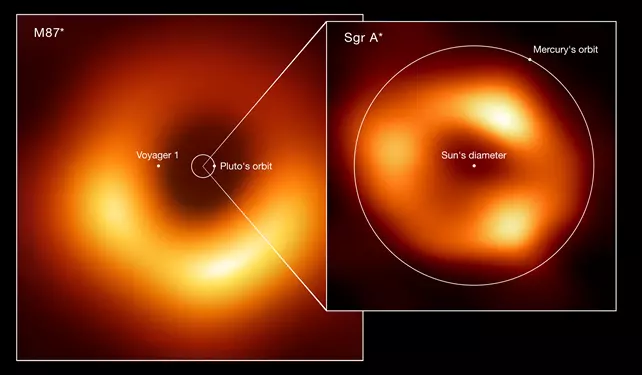
Size comparison of the two black holes imaged by the Event Horizon Telescope (EHT) Collaboration: M87*, at the heart of the galaxy Messier 87, and Sagittarius A* (Sgr A*), at the centre of the Milky Way. The image shows the scale of Sgr A* in comparison with both M87* and other elements of the Solar System such as the orbits of Pluto and Mercury. Also displayed is the Sun’s diameter and the current location of the Voyager 1 space probe, the furthest spacecraft from Earth. M87*, which lies 55 million light-years away, is one of the largest black holes known. While Sgr A*, 27 000 light-years away, has a mass roughly four million times the Sun’s mass, M87* is more than 1000 times more massive. Because of their relative distances from Earth, both black holes appear the same size in the sky. Credit: EHT collaboration (acknowledgment: Lia Medeiros (CC BY 4.0)
Stars orbiting Sagittarius A*
The stars orbiting close to Sagittarius A* are called “S stars.” Their close orbits and high velocities help astronomers determine the limits to the physical size of the Milky Way’s central black hole.
Observations with the Very Large Telescope in Chile and Keck Telescope in Hawaii have revealed stars orbiting Sgr A* at speeds much greater that those of any other stars in the Milky Way. One of these stars, designated S2 (or S0-2), was observed spinning around Sgr A* at speeds of over 5,000 km/s at its closest approach.
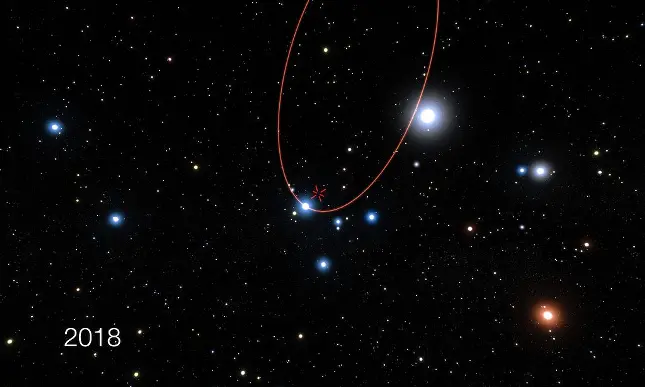
This artist’s impression shows stars orbiting the supermassive black hole at the centre of the Milky Way. The orbit of S2 is shown in red and the position of the central black hole is marked with a red cross. Image: ESO/L. Calçada
The star S2 was particularly useful for determining the mass and upper limits on the radius of Sgr A*. It is a member of a cluster near the black hole. It orbits Sgr A* with a period of 16.0518 years from a distance that varies from 970 astronomical units to 120 astronomical units (17 light hours). The star’s orbital period is only about 30% longer than that of Jupiter around the Sun, but at the closest approach, it does not come closer than four times the distance between the Sun and Neptune.
The European Southern Observatory (ESO) estimates the star’s initial mass at 14 solar masses. With the spectral type B0-2 V, S2 probably has a mass in the range from 10 to 15 solar masses.
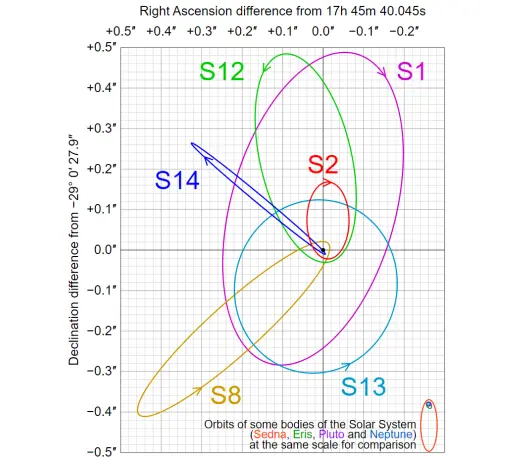
Inferred well-determined orbits of 6 stars around supermassive black hole candidate Sagittarius A* at the Milky Way galactic centre based on data from “SINFONI in the Galactic Center: Young Stars and Infrared Flares in the Central Light-Month” by Eisenhauer et al, The Astrophysical Journal, 628:246-259, 2005. Image: Wikimedia Commons/Cmglee (CC BY-SA 3.0)
A team of astronomers tracked the star during its close approach to the black hole in May 2018. They aimed to test Albert Einstein’s general theory of relativity, which predicts that a star coming close to a supermassive black hole should exhibit a relativistic redshift. They detected a combination of special relativistic and gravitational redshift, consistent with Einstein’s theory.
When S2 made its closest approach to Sgr A*, it reached a speed of 7,650 km/s, which is almost 3% of the speed of light.
Researchers (mainly from the Max Planck Institute for Extraterrestrial Physics) used the star’s orbital dynamics to measure the distance from the Earth to Sgr A*. They calculated it to be 7.94 ± 0.42 kiloparsecs.
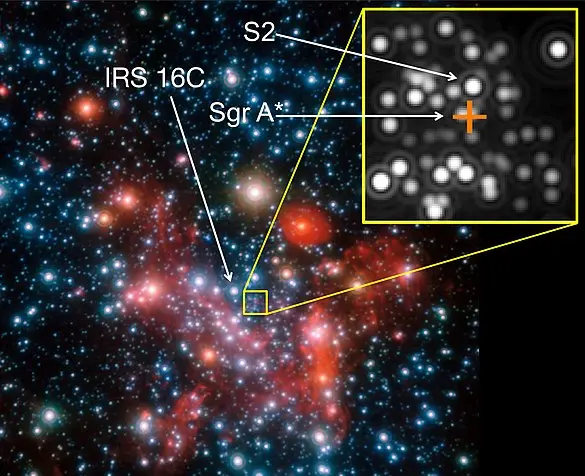
Image of the galactic centre. For the interferometric GRAVITY observations the star IRS 16C was used as a reference star, the actual target was the star S2. The position of the centre, which harbours the (invisible) black hole known as Sgr A*, with 4 million solar masses, is marked by the orange cross. Credit: ESO/MPE/S. Gillessen et al.
In 2012, a team led by Andrea M. Ghez (University of California, Los Angeles) reported the discovery of a star that orbits even closer to the supermassive black hole. Designated S55 or S0-102, the star orbits Sgr A* with a period of only 12.8 years. At its closest approach, S55 reached a speed 1.7% the speed of light.
In 2019, researchers detected a new record-holder. The star S62 orbits the black hole faster than any other star previously discovered. It has an orbital period of only 9.9 years and its orbit takes it within 16 AU of Sgr A*. This is less than the distance between the Sun and Uranus. At its closest approach, the star reaches a velocity that is 10% of the speed of light relative to Sgr A*.
The star S4714, the record-holder as of 2020, comes within 12.6 AU (1.88 billion km) of the black hole, a distance almost equal to that between the Sun and Saturn. At its closest approach, the star reaches a velocity of 23,928 ± 8,840 km/s, or about 8% the speed of light. S4714 orbits Sgr A* with a period of 12 years, but its highly eccentric orbit takes it very close to the black hole.
Milky Way black hole
In 2008, the results of 16-year long observations of stellar orbits around Sgr A* by Gillessen et al. were announced and published in The Astrophysical Journal in 2009. The team estimated the compact object’s mass to be 4.31 ± 0.38 million solar masses. The black hole itself can’t be seen, but observations of nearby objects are only consistent if there is one present in the vicinity of Sagittarius A*.
Reinhard Genzel, who led the research, said that it provided “what is now considered to be the best empirical evidence that super-massive black holes do really exist. The stellar orbits in the galactic centre show that the central mass concentration of four million solar masses must be a black hole, beyond any reasonable doubt.”
Sagittarius A* is not exactly centred on the black hole. If it were, we would be able to see the object magnified due to gravitational lensing. Its light would be bent by the gravity of the exceptionally massive object in the foreground.
As we do not see the object enlarged beyond its size, this indicates that the radio emissions of Sgr A* are not centred on the black hole but come from a bright spot in the area around it, near the event horizon. In other words, the emission does not come from the black hole itself, but from the material that the black hole is about to swallow up.
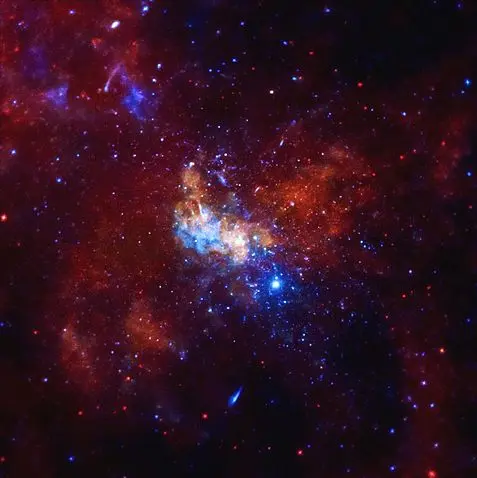
The supermassive black hole at the center of the Milky Way may be producing tiny particles, called neutrinos, that have virtually no mass and carry no electric charge. This Chandra image shows the region around the black hole, known as Sagittarius A*, in low, medium, and high-energy X-rays (red, green, and blue respectively.) Scientists have found a connection to outbursts generated by the black hole and seen by Chandra and other X-ray telescopes with the detection of high-energy neutrinos in an observatory under the South Pole. Image: Smithsonian Institution/Flickr Commons
Galactic centre
The Galactic centre is the rotational centre of our galaxy. The region around it forms a small part of the Milky Way’s galactic bulge. The area within one parsec of Sagittarius A contains about 10 million stars. Most of these are old red giants. Many are hot Wolf-Rayet stars and massive supergiants formed about a million years ago.
The position of Sagittarius A was adopted by the International Astronomical Union (IAU) as the zero coordinate point for the galactic longitude and latitude system in 1958.
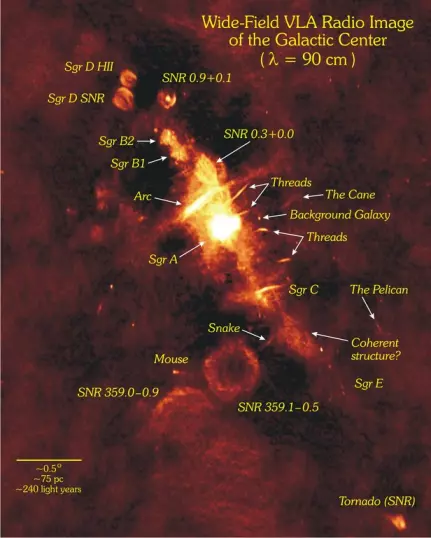
The diagonal line of bright objects in this image of the heart of our Milky Way Galaxy are all powerful sources of radio waves. The bright center is the home of the supermassive black hole, Sagittarius A*. The dense, bright circles are the nurseries of new, hot stars and the bubbles are remnants of massive stars that went out as supernovae. The thread-like shapes are not yet understood, but probably trace powerful magnetic field lines. This giant image was assembled from observations made by the Very Large Array (VLA). Credit: NRAO/AUI/NSF and N.E. Kassim, Naval Research Laboratory
In 2021, NASA released new images of the Galactic centre, based on observations with the Chandra X-ray observatory. The Chandra mapping of the central few degrees of the Milky Way revealed X-ray emitting threads and plumes emanating from the Galactic centre.
Sagittarius A size
Sagittarius A has a radius 31.6 times that of the Sun. The largest component, the supernova remnant Sagittarius A East, is about 25 light-years across.
The three components of Sagittarius A overlap. The spiral structure Sagittarius A West appears within Sgr A East, while Sagittarius A* lies at the centre of Sgr A West.
Size comparison
With a size of 31.6 solar radii, Sagittarius A is roughly the same size as Alnilam (32.4 R☉), the central star of Orion’s Belt. The radio source is slightly smaller than Polaris (37.5 R☉) and Aldebaran (45.1 R☉), and less than half the size of Canopus (73.3 R☉), Rigel (78.9 R☉), and Mirfak (68 R☉). It is larger than Arcturus (25.4 R☉), Alnitak (20 R☉), and Capella (11.98 R☉).
Mass
The compact radio source Sagittarius A* has a mass of 4.154 ± 0.014 million solar masses. The mass was derived from the orbit of the star S2 over the course of 27 years.
While its size is comparable to that of a large star, the mass of Sgr A* is 15,000 to 20,000 times that of the most massive stars known. The radio source is more massive than Omega Centauri, the largest known globular cluster in the Milky Way, which stretches about 150 light-years across and has a mass of 4.05 million Suns.
The mass of Sagittarius A* can be directly measured using the size and period of the orbit of any star in the vicinity. The stars near Sgr A* move in Keplerian orbits, i.e. in a two-dimensional orbital plane that takes the shape of an ellipse, parabola or hyperbola around the massive central body. However, the orbits of distant stars are not measured directly. They are inferred from the stars’ proper motions and Doppler shifts as they move toward or away from us.
The stars located within 0.5 arcseconds (3,700 astronomical units) of Sagittarius A* have orbital periods between 15 and 94 years. They move in highly elliptical orbits that are more similar to the orbits of comets than those of planets in the solar system.
Distance
Sagittarius A* lies 26,673 ± 42 light-years (8,178 ± 13 parsecs) away. The distance to Sgr A* was measured using the orbit of S2, a young B-type main sequence star on a 16-year orbit around the Galactic centre. The data used was collected during the star’s close passing to Sgr A* in May 2018.
The primary goal of the observations was to detect relativistic effects during a close approach to the supermassive black hole, but the data also allowed for the most accurate measurement to date of the distance to the Galactic centre, with only 0.3% uncertainty. The data was collected with GRAVITY, an interferometric instrument on the Very Large Telescope Interferometer (VLTI) at ESO’s Paranal Observatory in Chile. The interferometer combines the light of four VLT telescopes and can measure the positions of astronomical objects with a precision of a few ten microarcseconds.
Sagittarius A East
The supernova remnant Sagittarius A East is a non-thermal radio source located within 2 parsecs of the Milky Way’s centre.
Sgr A East is about 25 light years wide and is believed to have formed after a supernova event that occurred between 35,000 and 100,000 BCE. The size of the object indicates that it would have taken 50 to 100 times more energy than a standard supernova event to form a remnant this wide. For this reason, the star that went supernova is conjectured to have been gravitationally compressed because it had made a close approach to the Milky Way’s central black hole.
Sgr A East was first resolved from other structures in the region by the Advanced CCD Imaging Spectrometer (ACIS) on board the Chandra X-ray Observatory. The Chandra observations, reported in 2001, suggested that Sgr A East was a new metal-rich mixed-morphology supernova remnant. The researchers suggested that the remnant was formed after a Type II supernova event and that the progenitor star had a mass between 13 and 20 times that of the Sun. The size of the remnant’s radio shell is the smallest of the known mixed-morphology supernova remnants.
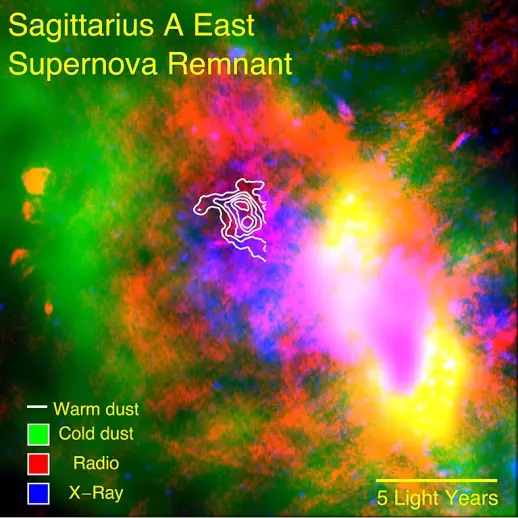
Using NASA’s Stratospheric Observatory for Infrared Astronomy (SOFIA), an international scientific team discovered that supernovae are capable of producing a substantial amount of the material from which planets like Earth can form. SOFIA data reveal warm dust (white) surviving inside a supernova remnant. The SNR Sgr A East cloud is traced in X-rays (blue). Radio emission (red) shows expanding shock waves colliding with surrounding interstellar clouds (green). The findings were published in the journal Science in 2015. Credit: NASA/CXO/Herschel/VLA/Lau et al
The researchers found that the non-thermal radio emission from Sgr A East was heavily absorbed by Sgr A West, indicating that, from our point of view, Sgr A West lies in front of Sgr A East.
In 2021, observations with NASA’s Chandra X-ray Observatory revealed that Sgr A East was in fact produced in a Type Ia supernova, a supernova event that occurs in binary systems composed of a white dwarf and a companion. If a white dwarf accretes too much mass from the binary companion, its core reaches the ignition temperature for carbon fusion. Subsequently there is a runaway reaction that releases enough energy to produce a supernova event. In the case of Sgr A East, the researchers suggested that the remnant was created in a less powerful supernova, classified as Type Iax.
Sagittarius A West
Sagittarius A West is a thermal radio source, an HII region that appears on the west side of the Sagittarius A complex. It is sometimes called the “Minispiral” because it appears as a three-arm spiral when observed from Earth.
However, the object’s appearance is misleading because its structure is not really that of a spiral. It is made of clouds of dust and gas that orbit Sgr A* and fall onto it at great velocities, up to 1,000 km/s. The surface layer of the clouds is ionized by a hundred or more massive OB stars in this region.
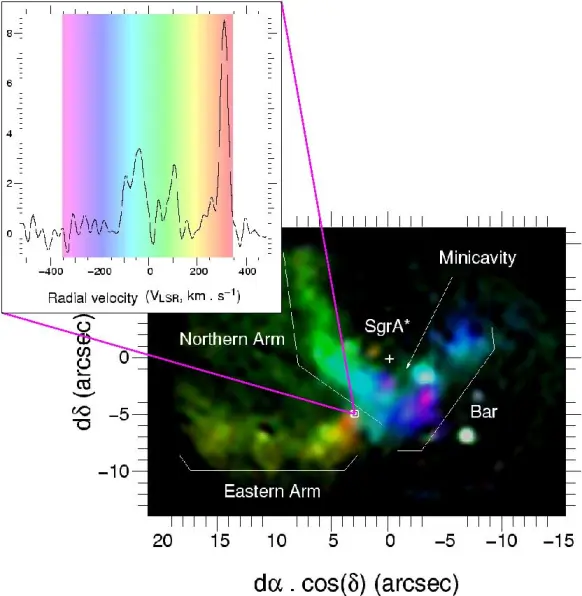
The Sagittarius A West complex of ionized gas, here observed in the Bracket gamma line of ionized Hydrogen, has the apparent shape of a three-arm spiral. The image above was produced using data obtained with the BEAR spectro-imager on the Canada-France-Hawaii Telescope. The color shades represent different radial velocities, explicited on the spectrum in the upper-left inset, which corresponds to the selected pixel. Image: Thibaut Paumard (CC BY-SA 3.0)
The Sgr A West structure is surrounded by a Circumnuclear Disk (CND), a massive clump of molecular gas. The Northern Arm of Sgr A West is believed to have once been a clump in the CND, and the Western Arc is thought to be the ionized inner surface of the CND. The Bar and the Eastern Arm appear as large clouds similar to the Northern Arm, but they do not have the same orbital plane. These structures are about a few light-years in size.
Sgr A West also hosts many smaller clouds and holes. The most prominent of these is called the Minicavity. It is believed to be a bubble blown inside the Northern Arm by the powerful wind of a massive star.
Location
The location of Sagittarius A and the Galactic centre in the night sky is easy to pinpoint. The Galactic centre lies in Sagittarius, about 5.6 degrees south of the ecliptic and not far from the Archer’s bow. It appears in the same area of the sky as the Lagoon Nebula (Messier 8), the Butterfly Cluster (Messier 6), and Shaula (Lambda Scorpii), the star that marks the Scorpion’s stinger.
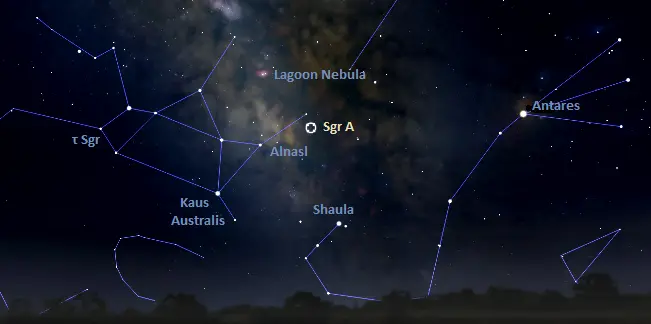
The location of Sagittarius A in the sky, image: Stellarium
Sagittarius A is found near the Teapot asterism in Sagittarius, roughly halfway between Antares, the brightest star in Scorpius, and Tau Sagittarii, the bottom star of the handle of the Teapot. It appears near Alnasl, the star that marks the spout of the Teapot.
The Galactic centre appears close to Baade’s Window, an area with relatively little obscuring dust, often used as an observational window to study the stars in the Milky Way’s central bulge. The area was named after the German astronomer Walter Baade, who identified it in the 1940s.
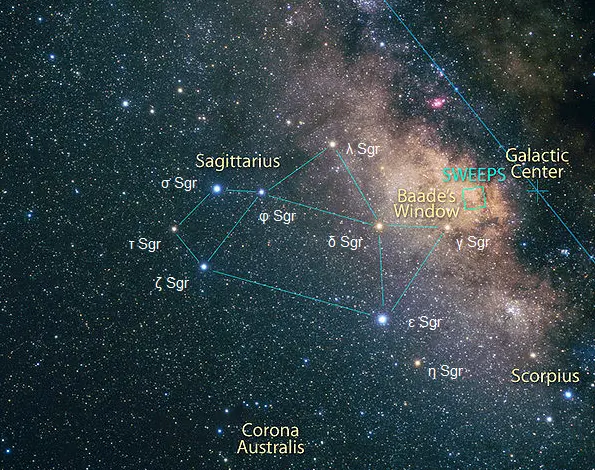
The SWEEPS target area is in the Sagittarius constellation, toward the center of the Milky Way galaxy. The target area is a rare transparent window to the distant central bulge stars located approximately 27,000 light-years away from Earth. The location of the SWEEPS area is indicated on this Milky Way image in blue. Image: NASA, ESA, Z. Levay (STScI) and A. Fujii
Facts
The radio signal coming from the Milky Way in the direction of the constellation Sagittarius was first detected by American physicist and radio engineer Karl Jansky. Jansky discovered the signal in September 1932 and announced the discovery at a meeting in Washington, D. C. in April 1933.
Jansky followed the signal for several months and found that it repeated on a cycle of 23 hours and 56 minutes, which corresponds to the length of a sidereal day. He consulted astronomical charts and concluded that the signal emanated from the Milky Way and was the strongest in Sagittarius. He called the radiation “Star Noise” and wanted to investigate it further, but he could not get financial support during the Great Depression.
In 1951, Australian physicists and radio scientists John H. Piddington and Harry C. Minnett reported the discovery of a bright “Sagittarius-Scorpius” radio source near the centre of the Milky Way. They used the Commonwealth Scientific and Industrial Research Organisation (CSIRO) radio telescope in Sydney.
In 1955, Americans R. X. McGee and J. G. Bolton found the radio source and were the first to propose that it could be the centre of the Milky Way in a letter to Nature journal.
The component Sagittarius A* was discovered by Bruce Balick and Robert Brown on February 13 and 15, 1974 at the National Radio Astronomy Observatory (NRAO). Brown was the one to name the source Sagittarius A*. Balick and Brown published their discovery in the Astrophysical Journal in December 1974.
In 1994, a Berkeley team that included Charles H. Townes and Reinhard Genzel used infrared and submillimetre spectroscopy and demonstrated that the radio source had a mass of about 3 million solar masses.
In October 2002, Reinhard Genzel led an international team at the Max Planck Institute for Extraterrestrial Physics that observed the motion of the star S2 over the course of 10 years. The team ruled out the possibility that the radio source contained a mass of dark stellar objects or degenerate matter.
In 2008, Gillessen et al. presented their findings after observing the stars orbiting Sgr A* for 16 years. Reinhard Genzel led the team that conducted the research. The team estimated the mass of Sgr A* at 4.31 ± 0.38 million Suns, strongly indicating the presence of a black hole. The study was published in The Astrophysical Journal in 2009. It provided the best empirical evidence to date of the existence of supermassive black holes.
Conclusive evidence that the radio source Sgr A* was a black hole came in a study published in 2018. Genzel and an international team used the GRAVITY interferometer and the four telescopes of the Very Large Telescope (VLT) to create a 430-foot telescope. They observed clumps of gas moving at around 30% of the speed of light near Sgr A*. Three prominent flares were visible near the black hole, believed to originate from magnetic interactions in the hot gas near Sgr A*.
The dark dust lane that hides the Milky Way centre from view also obscures most radial centres of the galaxy from our perspective. Known as the Great Rift, the dark band lies between solar system, which lies in the Orion Arm of the Milky Way, and the Sagittarius Arm, the next arm in the direction of the Galactic centre. The Great Rift stretches from Cygnus to Centaurus and obscures the galaxy’s bright bulge.
In 2005, observations with the European Space Agency’s INTErnational Gamma-Ray Astrophysics Laboratory (INTEGRAL) revealed that the Milky Way’s black hole was significantly more active 350 years ago, when it released a million times the amount of energy than it does now. Sgr A* was flooded in gamma rays due to dramatic interactions with its surroundings over the course of at least a decade. Astronomers expect it to become active again in the future.
The team of researchers learned of the black hole’s past by studying Sagittarius B2, a giant cloud of molecular hydrogen gas that lies roughly 350 light-years from Sgr A*. Because it is 350 light-years away, Sgr B2 is only now absorbing the gamma ray radiation emitted by the black hole 350 years ago. The cloud became fluorescent in the X-ray band.
In 2012, astronomers reported the discovery of a dense cloud of gas with a mass three times that of the Earth, moving toward the accretion zone of Sagittarius A*. The discovery was reported in Nature. The cloud, designated G2, was expected to make a close approach to the black hole in 2013. While it would not be a direct collision course, computer simulations showed that the cloud would not survive the encounter due to tidal stretching from Sgr A*. The hypothesis was tested when the gas cloud made the closest approach to Sgr A*.
Astronomers believed that the encounter would give them an opportunity to observe how material accretes onto supermassive black holes. The cloud’s closest approach, within only 36 light-hours of the black hole, was observed with the Chandra X-ray Observatory (CXO), the XMM-Newton space observatory, the Very Large Array (VLA), the INTEGRAL space telescope, the Neil Gehrels Swift Observatory, and the Fermi Gamma-ray Space Telescope (FGST).
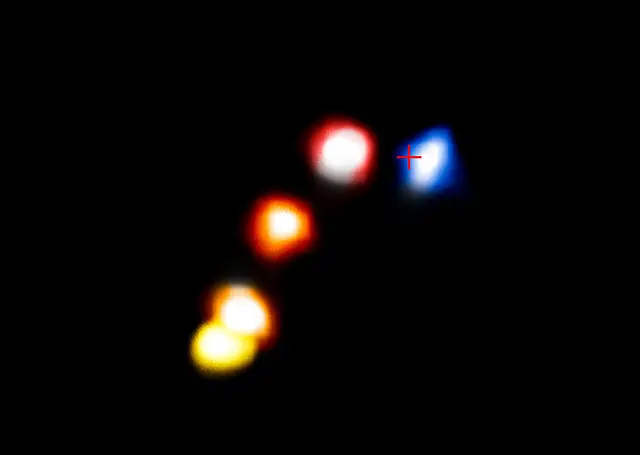
This composite image shows the motion of the dusty cloud G2 as it closes in on, and then passes, the supermassive black hole at the centre of the Milky Way. These observations with ESO’s VLT have shown that the cloud appears to have survived its close encounter with the black hole and remains a compact object that is not significantly extended. In this image the position of the cloud in the years 2006, 2010, 2012 and February and September 2014 are shown, from left to right. The blobs have been colourised to show the motion of the cloud, red indicated that the object is receding and blue approaching. The cross marks the position of the supermassive black hole. Image: ESO/A. Eckart
However, nothing out of the ordinary was detected. Based on observations on March 19 and 20, 2014, researchers from the UCLA Galactic Center Group reported that G2 was intact after the encounter.
A team led by Andrea Ghez observed G2 with the W. M. Keck Observatory on Mauna Kea in Hawaii and reported that the cloud had survived its closest approach to the black hole. Additionally, its brightness measurements were consistent with those in the past decade and its motion continued to be consistent with a Keplerian model. This indicates that G2 is not an ordinary gas cloud and that it has central star. The researchers proposed that the star has a luminosity 30 times that of the Sun and is surrounded by a large, thick dust shell. They also suggested that the star may be a product of a binary star merger.
In 2019, scientists reported that the central black hole had been consuming the surrounding matter much faster than usual. The team led by Andrea Ghez at the University of California, Los Angeles (UCLA), observed Sgr A* consuming matter at an unprecedented rate. They analysed more than 13,000 observations since 2003 made with the Keck Observatory in Hawaii and the European Southern Observatory’s (ESO) Very Large Telescope in Chile. They found that the area just outside the event horizon was twice as bright as during the previous brightest observation. After analysing data dating back 24 years, the team concluded that this level of brightness had not been seen in the last quarter of a century.
Some researchers suggested that Sagittarius A* had stripped the outer layer of G2 when the cloud passed through.
The discovery of an infrared and radio object, designated GCIRS 13E, was reported in November 2004. The object was detected orbiting three light years from Sgr A*. It was resolved into a cluster of seven stars (Wolf-Rayet and O-type stars) and its mass was estimated at 1,300 solar masses. To account for the mass, astronomers proposed that there may be an intermediate-mass black hole at the centre of the cluster. The cluster is believed to have moved toward the Milky Way’s central black hole in the last 10 million years because such massive stars cannot form so close to a supermassive black hole.
Andrea Ghez and Reinhard Genzel were jointly awarded the 2020 Nobel Prize in Physics for their decades-long work that led to the evidence of the existence of a supermassive black hole at the centre of the Milky Way. They each led teams of astronomers that mapped the orbits of the nearby stars and developed methods, techniques, and instruments to see through the dense dust and gas clouds to the Milky Way centre. Ghez and Genzel shared the Nobel Prize with Sir Roger Penrose (University of Oxford), the British mathematician and mathematical physicist who used mathematical methods to prove that black holes really can form, as predicted by Einstein’s theory of general relativity.